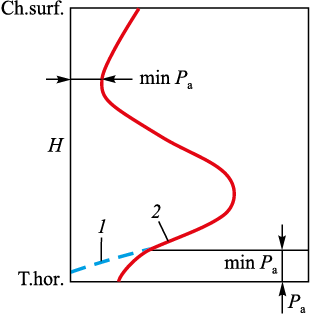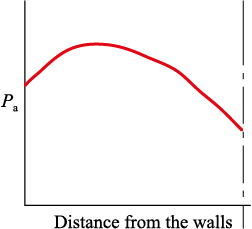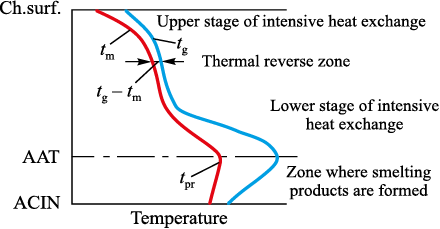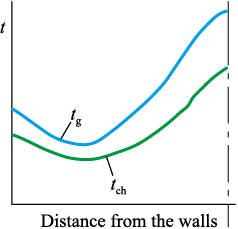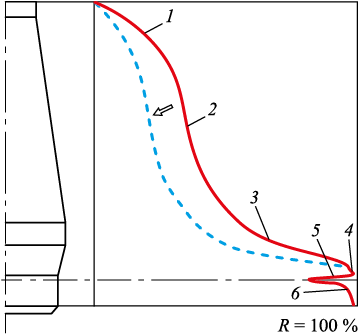Scroll to:
Reduction of specific coke consumption in blast furnace by impact on thermal reverse zone
https://doi.org/10.17073/0368-0797-2023-4-394-402
Abstract
At the blast furnace of PJSC “Magnitogorsk Metallurgical Plant” (MMK), the specific consumption of coke was reduced by impact on thermal reverse zone (TRZ) by increasing the consumption of natural gas above 120 m3/t of cast iron under conditions of increased reactivity and reduced hot strength of coke. In the first pair of periods, an increase in CRI from 38.4 to 39.3 % with a decrease in CSR from 36.3 to 34.6 % was accompanied by an increase in the ratio of natural gas consumption and total oxygen entering the furnace from 0.43 to 0.45 by increasing the specific gas consumption from 123.2 to 133.5 m3/t of cast iron. The set of actions increased the TRZ length towards the blast-furnace mouth by 1.9 % with its unchanged location along the lower part. Reducing the heat consumption in the TRZ increased the temperature difference between gas and materials there by an average of 36 °С. In the second pair of periods, the consumption of natural gas was 143.9 m3/t of cast iron with a decrease in the oxygen content in the blast from 27.6 to 27.0. They were accompanied by the following changes in the processes under consideration: an increase in the length of the TRZ towards the blast-furnace mouth by 2.6 % and the distance from the tuyere hearth by 3.4 %, an increase in the degree of carbon reduction from 32.0 to 33.3 %, an insignificant (on average 0.3 °С) increase in the temperature difference of gas and materials in the TRZ. In the first pair of periods, reduction in the coke specific consumption was 4.7 kg/t of cast iron with an increase in furnace productivity by 27 t/day. Conditions and course of the processes of the second pair ensured a decrease in the coke specific consumption by 1.6 kg/t of cast iron and led to a decrease in cast iron production by 41 t/day.
For citations:
Kharchenko A.S., Sibagatullina M.I., Kharchenko E.O., Makarova I.V., Sibagatullina S.K., Beginyuk V.A. Reduction of specific coke consumption in blast furnace by impact on thermal reverse zone. Izvestiya. Ferrous Metallurgy. 2023;66(4):394-402. https://doi.org/10.17073/0368-0797-2023-4-394-402
Introduction
The question of determining the rational parameters for combined blast during blast furnace smelting, in alignment with the developmental goals of ferrous metallurgy, remains pertinent [1 – 4]. The simultaneous utilization of reducing additives in the form of natural gas and pulverized coal fuel, with the ratio of their flow rates to that of the process oxygen ranging from 0.9 to 1.2, has contributed to the stabilization of theoretical combustion temperature and other process parameters. The degrees of direct and indirect reduction are notable factors in these processes [5]. Upon analyzing the operation of blast furnaces at PJSC “Magnitogorsk Metallurgical Plant” (MMK), the significant role of the reactivity index and coke strength after the reaction was further confirmed [6]. In the context of blast furnaces in Japan, it becomes imperative to estimate the initial gasification temperature of carbonaceous materials as the thermal reverse zone (TRZ) takes shape. The study presented in reference [7] delves into the injection of hydrogen as a reducing agent, replacing carbon, with the aim of mitigating CO2 oxide emissions. Simultaneously, this approach enhances the efficiency of reduction through CO gaseous oxide. The experiment demonstrated that the reduction of CO2 oxide emissions from the blast furnace is achieved within a hydrogen concentration range of up to 20 %.
The papers [8 – 11] underscore the vital role of mathematical models due to the scarcity of information on process parameters such as temperature, pressure, and reduction levels along height of the furnace. The processes that arise and evolve within the TRZ, leading to a substantial increase in iron reduction, are pivotal elements within these evolving mathematical models. These models are currently in development and implementation. The kinetic modeling, encompassing an evaluation of the thermal reverse zone’s impact on blast furnace operations, is congruent with this perspective [7]. An investigation was conducted to assess the influence of material temperature upon charging into the furnace, their reductibility, and gas pressure at the furnace’s mouth on the outcomes of blast furnace smelting. The findings revealed that as gases become more actively utilized within the furnace, the temperature at the onset of the thermal reverse zone decreases [9]. The paper [12] has illustrated that the specific consumption of coke diminishes with an increase in the duration of time the charged materials spend within the TRZ. A noteworthy reduction of 3.6 kg/t of cast iron was achieved [13] by mitigating heat outflow from the region where Wch /Wg ≥ 1 to the area where Wch /Wg < 1, with Wch and Wg representing the heat capacities of charge and gas flows, respectively. In the thermal reverse stage (Wch ≈ Wg ), the temperature registered a decline of 2.5 °C, while the temperature differential between the gas and the charge contracted by 1.3 °C.
An evaluation of rational approaches concerning blast furnaces at MMK has unveiled the substantial significance of coke reactivity index and post-reaction strength in relation to the adjustment of natural gas consumption [6]. This complements prior explorations of these phenomena [14 – 19]. Theoretical and experimental investigations have contributed to the recognition of the importance of temperature boundaries distinguishing between indirect, mixed, and direct reduction regions [14]. The values characterizing these boundaries exhibit interrelationships with the rates of oxide reduction by gases such as CO and H2 , as well as the rates of carbon gasification by gaseous reduction products, СО2 and Н2О [16].
In laboratory experiments, where the charge was maintained under identical temperature and time conditions as those in the upper section of the blast furnace shaft, a comparison was conducted between charcoal and coke concerning their influence on the degree of sinter reduction by a gas mixture comprising 29 % CO, 2 % H2 and 60 % N2 [16]. The results obtained were as follows:
|
Based to these data, at temperatures corresponding to intense heat exchange in the upper section of the furnace (up to 750 °C), the reduction degree exhibited only a marginal increase, with fuel reactivity nearly unchanged. Simultaneously, the flue gas composition contained approximately 10.4 – 10.8 % СО2 . At temperatures corresponding to the initiation and progression of the thermal reverse zone (above 750 °C), a portion of CO2 oxide engaged in interactions with carbon from the fuel, leading to the formation of CO oxide. The formation of CO oxide by charcoal, a fuel with a higher reactivity index, contributed more significantly to the enhancement of sinter reduction compared to its formation by coke. This effect assumed considerable importance in the optimization of the blast furnace process as natural gas consumption increased [18].
Experiments that involved the examination of coke samples extracted from the pilot blast furnace unveiled four different reactivity pathways. The outcome of these pathways includes the potential reduction of coke-specific consumption and the augmentation of blast intensity. Furthermore, the ability of coke carbon to react with СО2 oxide was also observed to increase [20 – 22]. In practical applications, these findings can be implemented by incorporating machine vision systems for both the upper and lower sections of the blast furnace [23 – 29]. Additionally, they align with concepts associated with the electronic theory of iron reduction from oxides [30; 31].
Materials and methods
Using the insights gathered from the works [1 – 31], we successfully reduced coke-specific consumption within a blast furnace with a production capacity of 1370 m3. This reduction was achieved by strategically manipulating the thermal reverse zone, primarily through an increase in natural gas-specific consumption, while concurrently adjusting the coke reactivity index (CRI) and coke strength after reaction (CSR) in opposite direction. The most important operational characteristics of the furnace are depicted in Fig. 1 – 4.
The vertical pressure behavior (active weight Ра ) of materials along both the height and the cross-section of the furnace is presented in Fig. 1 and 2.
Fig. 1. Vertical pressure of materials from charge surface (Ch. surf.)
Fig. 2. Vertical pressure of materials from lining to the blast furnace axis |
Average temperature trends along the height of the blast furnace are depicted in Fig. 3, while those concerning temperature distribution by radius are illustrated in Fig. 4 and 5. These figures are constructed based on the findings and insights from the referenced papers [14; 17; 22].
When temperatures fall below the range of 850 – 900 °C, it is observed that the heat capacity of the gas flow surpasses that of the charge flow (Wg > Wch ), while the Wch /Wg ratio remains within the range of 0.7 – 0.9. This surplus heat in the upper heat exchange phase, not absorbed by the charge, finds application in low-temperature processes without necessitating an increase in the quantity of coke introduced into the furnace. Notably, no additional coke is required for moisture evaporation.
Fig. 3. Scheme of temperature changes of materials (tm ) and gases (tg )
Fig. 4. Diagram of changes in temperatures of the charge (tch )
Fig. 5. Nature of changes in reduction degree |
Fig. 5 illustrates the portion of oxygen from all oxides extracted from the charged materials by various reducing agents. In the figure: 1 – accelerated reduction occurring in the upper part of the blast furnace, which is attributed to the low stability of the chemical bond of Fe2O3 and Fe3O4 ; 2 – reduction taking place in the conditions of the thermal reverse zone, which are highly conducive to reactions FeO + CO = Fe + CO2 and FeO + H2 = Fe + H2O, with each unit of temperature change significantly influencing the reduction process; 3 – accelerated reduction due to the intensity of its direct progression (FeO + C = Fe + CO); 4 – slower reduction occurring as the process reaches its conclusion, with only a few unreduced oxides remaining; 5 – a decrease in the reduction degree due to the oxidation of smelting products in tuyere hearths; 6 – rapid reduction of elements, mainly iron, previously oxidized in tuyere hearths. The solid line in the figure corresponds to modern blast furnace smelting conditions, while the dashed line signifies potential advancements in blast furnace smelting technology.
Results and discussion
At the blast furnace of MMK, the reduction in coke-specific consumption was achieved by elevating the utilization of hydrogen and augmenting the degree of iron reduction from FeO oxide. This was accomplished by influencing the thermal reverse zone, leading to an increase in natural gas consumption exceeding 120 m3/t of cast iron. The study focused on two paired periods: I and II (the first pair) and III and IV (the second pair). The periods within each pair were contiguous, primarily spanning seven days each.
During period I of the first pair, under the initial conditions, the natural gas flow rate stood at 123.2 m3/t of cast iron. When the blast contained 27.2 % of oxygen, the ratio of gas and oxygen consumption equated to 0.43 (Table 1). In the second pair (base period III), these values increased to 135.8 m3/t of cast iron; 27.6 % oxygen and a ratio of 0.47, respectively.
Table 1. Parameters of the blast and blast-furnace gas
| |||||||||||||||||||||||||||||||||||||||||||||||||||||||||||||||||||||||||||||||||||||||||||||||||||||||||||||||||||||||||
In both pairs of periods, several key parameters experienced growth, including the mass of the gas-air mixture per tuyere, its kinetic energy of efflux, and the extent of the loose portion of the tuyere hearth. Notably, these parameters exhibited more pronounced changes in the first pair of periods.
The coke strength after reaction CSR under the baseline conditions of the first pair of periods amounted to 36.3 %, with a reactive index (CRI) of 38.4 %. During the renewed smelting mode, CRI increased by 0.9 % to reach 39.3 %. In the basic conditions of the second pair, CSR was 39.5 %, and CRI was 39.1 %, with a variation reducing CRI to 37.8 % (Table 2).
Table 2. Quality indicators of the charge materials
| ||||||||||||||||||||||||||||||||||||||||||||||||||||||||||
In period II, as compared to period I, CSR decreased from 36.3 to 34.6 %, and CRI increased from 38.4 to 39.3 %. This change resulted in an increase in the ratio of natural gas consumption to the total oxygen entering the furnace, rising from 0.43 to 0.45. The gas-specific consumption also increased from 123.2 to 133.5 m3/t of cast iron. Additionally, the oxygen content in the blast increased from 27.2 to 28.4 %. These alterations facilitated an increase in hydrogen reduction from 31.9 to 37.2 % (Table 3) and an enhancement in its utilization, from 45.3 to 48.8 %. Meanwhile, the length of the TRZ increased towards the blast furnace mouth by 1.9 %, while its position at the bottom remained unchanged. A significant reduction in carbon reduction, from 30.7 to 24.4 %, led to a decrease in heat consumption within the TRZ, resulting in an average temperature difference tg – tch (Fig. 3) increasing by 36 °С.
Table 3. Reduction distribution indicators
| |||||||||||||||||||||||||||||||
In period IV, in comparison to period III, the main factors pertaining to smelting conditions underwent the following changes:
– an increase in natural gas consumption from 135.8 to 143.9 m3/t of cast iron;
– a decrease in the oxygen content in the blast from 27.6 to 27.0 %;
– an increase in the ratio of natural gas consumption to the total oxygen entering the furnace from 0.47 to 0.51;
– a decrease in CRI from 39.1 to 37.8 %;
– an increase in CSR from 39.5 to 40.2 %.
As a result, several changes in the studied processes during period IV, compared to period III, were observed:
– an increase in the length of the TRZ towards the blast-furnace mouth by 2.6 % and the distance from the tuyere hearth by 3.4 %;
– an increase in the degree of carbon reduction from 32.0 to 33.3 %;
– a slight, albeit insignificant, increase in the temperature difference tg – tch (Fig. 3), averaging only 0.3 °С.
The key thermal performance characteristics accompanying these alterations are detailed in Table 4.
Table 4. Heat consumption indicators
| |||||||||||||||||||||||||||||||
In terms of the recorded parameters, the temperature in the axial zone of the blast-furnace mouth decreased by 14 °С in period II when compared to period I, and conversely, it increased by 20 °C in period IV when compared to period III (Table 1).
The series of modifications within the processes, encompassing the ratios Тper/Тg , Тper/Тc , Тc/Тg , resulted in a reduction in coke-specific consumption in period II compared to period I from 434.9 to 430.2 kg/t of cast iron, while in period IV, in comparison to period III, from 437.5 to 435.9 kg/t of cast iron (Table 5). During the first pair of periods, furnace productivity increased by 27 t/day; however, the conditions and progression of the processes during the second pair led to a decrease in cast iron production by 41 t/day (Table 5).
Table 5. Main technological indicators of the furnace
| |||||||||||||||||||||||||||||||||||||||||||||||||||||||||||||||||||||||||||||||||||||
The shift of the coke carbon gasification process in period II, in comparison to period I, led to a 6.9 % reduction in the factor of charge and its product’s resistance to gas movement in the lower part of the bosh (Fig. 1, the region of minimal Pa value). This shift also facilitated smelting with an 11.5 % increase in lift force of the gas flow (Table 1). The shift of the coke carbon gasification region in period IV compared to period III to the region of lower temperatures led to a decrease in the coke specific consumption and the processes rate, resulting in decline of the furnace output (Table 5).
Conclusions
The parameters, such as length, height location, temperature, and the temperature difference between rising gases and descending materials within the blast furnace’s TRZ, exert significant influence on coke-specific consumption. The formation of the TRZ is contingent on various factors, including the coke reactivity index (CRI), coke strength before reaction (CSR), natural gas consumption, and process oxygen consumption.
At the blast furnace of MMK, a series of smelting operations were conducted, categorized into two pairs of periods: the first pair serving as the base period and the second as the experimental period.
The first pair of periods witnessed an increase in natural gas consumption, rising from 123.2 to 133.5 m3/t of cast iron. The length of the TRZ extended towards the blast furnace mouth by 1.9 %, maintaining its position at the bottom unchanged. Simultaneously, the temperature gradient between the gas and materials surged by 36 °C. Conversely, in the second pair of periods, natural gas consumption increased from 135.8 to 143.9 m3/t of cast iron. The TRZ expanded towards the blast furnace mouth by 2.6 %, and the distance from the tuyere hearth extended by 3.4 %. However, the temperature difference between the gas and materials within the TRZ registered a negligible increase, averaging just 0.3 °С.
In the first pair of periods, a reduction in coke-specific consumption by 4.7 kg/t of cast iron was achieved, resulting in a notable increase in furnace productivity by 27 t/day. However, in the second pair, coke-specific consumption decreased by 1.6 kg/t of cast iron, leading to a decrease in cast iron production by 41 t/day.
References
1. Grigorovich K.V. Metallurgy of the 21st century: Challenges and tasks of modernizing the industry in the Russian Federation. In: Physico-Chemical Bases of Metallurgical Processes (FHOMP 2022). Proceedings of the Int. Sci. Conf. named after Academician A.M. Samarin. Vyksa: Publ. house of JSC “Vyksa Metallurgical Plant”; 2022:37–44. (In Russ.).
2. Elanskii D.G. Carbon-free ferrous metallurgy – paths and their cost. In: Proceedings of the XVI Int. Congress of Steelmakers and Metal Producers. Yekaterinburg; 2021:51–56. (In Russ.).
3. Nedelin S.V. Prospects for development of ferrous metallurgy taking into account environmental restrictions. In: Proceedings of the XVI Int. Congress of Steelmakers and Metal Producers. Yekaterinburg; 2021:38–44. (In Russ.).
4. Torokhov G.V., Travyanov A.Ya., Golubev O.V., Chernousov P.I. Modern state and prospects for iron metallurgy. In: Proceedings of the XVI Int. Congress of Steelmakers and Metal Producers. Yekaterinburg; 2021:26–37. (In Russ.).
5. Chernousov P.I., Seregin S.N., Grishin R.E., Chikalova A.N. Investigation of blast-furnace process with multi-component blast. Сhernye metally. 2021;(12):4–10. (In Russ.).
6. Kharchenko A.S., Sibagatullin S.K., Pavlov A.V., Polinov A.A. Rational technological solutions for production of cast iron in blast furnaces of PJSC MMK. Сhernye metally. 2021;(12):10–15. (In Russ.).
7. Yokoyava Hirokazu, Kasai Eiki, Naitou Masaaki. Reduction of CO2 emissions from blast furnace applying reactive coke agglomerate and hydrogen reduction. Tetsu-to-Hagane. 2022;108(6):335–342. https://doi.org/10.2355/tetsutohagane.TETSU-2021-118
8. Dmitriev A.N., Vit’kina G.Yu., Alektorov R.V., Zolotykh M.O., Vyaznikova E.A. Proposals for the use of information technologies in improving blast-furnace process. In: Int. Forum. Dialogue of Metallurgists: Forecast for the Development of the industry until 2030. Price and Technology Solutions. April 21-22. Moscow; 2022:11–14. (In Russ.).
9. Dmitriev A.N., Vitkina G.Yu, Chesnokov Yu.A. Mathematical modeling and practical tasks solution of blast furnace smelting and adjacent repartitions. Proceeding of Shechtman International Symposium. 2016;3:369–376.
10. Dmitriev A.N., Chesnokov Yu.A., Chen K., Ivanov O.Yu., Zolotykh M.O. Monitoring the wear of the refractory lining in the blast-furnace hearth. Steel in Translation. 2013;43(11): 732–739. https://doi.org/10.3103/S0967091213110041
11. Dmitriev A.N., Chesnokov Yu.A., Chen K., Ivanov O.Yu., Zolotykh M.O. New monitoring system of firebrick lining deterioration of blast furnace devil in metallurgical plants of China. Advanced Materials Research. 2013; 834-836:939–943. https://doi.org/10.4028/www.scientific.net/AMR.834-836.939
12. Stefanovich M.A., Baertuev A.A., Sibagatullin S.K. Role of optimization of blast-furnace domain process with combined blast. In: Problems of Automated Management of Blast-Furnace Production. Kiev: Institut avtomatiki; 1973;3:31–32. (In Russ.).
13. Sibagatullin S.K., Kharchenko A.S., Minikaev S.R., Iglikova U.Zh., Polinov A.A., Gushchin D.N. Study of influence of iron-magnesia ore addition to sinter charge on blast furnace heat indices. Ferrous Metallurgy. Bulletin of Scientific, Technical and Economic Information. 2020;76(9):910–920. (In Russ.).
14. Gurin I., Spirin N., Lavrov V. Automated information system for control and diagnostics of the blast furnace slag mode. Lecture Notes in Electrical Engineering. 2022;857:256–264. https://doi.org/10.1007/978-3-030-94202-1_25
15. Spirin N.A., Lavrov V.V., Rybolovlev V.Yu., Shnaider D.A., Krasnobaev A.V., Gurin I.A. Digital transformation of pyrometallurgical technologies: State, scientific problems and prospects of development. Izvestiya. Ferrous Metallurgy. 2021;64(8):588–598. https://doi.org/10.17073/0368-0797-2021-8-588-598
16. Gol’dshtein N.L., Zlatoustovskii D.M., Zvereva N.N., etc. Reactivity of coke in a blast furnace. Stal’. 1975;(11):977–981. (In Russ.).
17. Babarykin N.N. Theory and Technology of Blast-Furnace Process. Magnitogorsk: MSTU; 2009:257. (In Russ.).
18. Sibagatullin S.K., Kharchenko A.S., Selivanov V.N., Beginyuk V.A., Chernov V.P. Improving the blast furnace process by raising the natural gas flow rate in the upper heat exchnage stage. Vestnik of Nosov Magnitogorsk State Technical University. 2017;15(1):37–44. (In Russ.). https://doi.org/10.18503/1995-2732-2017-15-1-37-44
19. Dmitriev A.N., Spirin N.A. Use of modern information technologies to analyze and control the blast-furnace process. Ferrous Metallurgy. Bulletin of Scientific, Technical and Economic Information. 2014;1(1369):21–25. (In Russ.).
20. Abas R.A., Jakobson A., Hayashi M., etс. Studies on graphitisation of blast coke by X-ray diffraction analysis and thermal diffusivity measurements. Steel Research International. 2006;77(11):763–769. https://doi.org/10.1002/srin.200606460
21. Natsui T., Sunahara K., Ujisawa Y. Effects of gasification and smelting reductionon coke. Tetsu-to-Hagane. 2008;92(12):841–848. https://doi.org/10.2355/tetsutohagane1955.92.12_841
22. Mousa E., Senk D., Babich А. Reduction of pellets-nut coke mixture under simulating blast furnace conditions. Steel Research International. 2010;81(9):706–715. https://doi.org/10.1002/srin.201000047
23. Spirin N., Onorin O., Istomin A. Prediction of blast furnace thermal state in real-time operation. Solid State Phenomena. 2020;299:518–523. https://doi.org/10.4028/www.scientific.net/SSP.299.518
24. Spirin N.A., Rybolovlev V.Yu., Lavrov V.V., Shnaider D.A., Krasnobaev A.V., Onorin O.P. Improving metallurgical information systems: blast-furnace applications. Steel in Translation. 2019;49(2):118–122. https://doi.org/10.3103/S0967091219020141
25. Pavlov A.V., Polinov A.A., Spirin N.A., Onorin O.P., Lavrov V.V., Gurin I.A. Decision-making support in blast-furnace operation. Steel in Translation. 2019;49(3):185–193. https://doi.org/10.3103/S0967091219030082
26. Teng Z., Cheng S., Du P., Guo X. Mathematical model of burden distribution for the bell-less top of a blast furnace. International Journal of Minerals, Metallurgy, and Materials. 2013;20(7):620–626.
27. Jiménez J., Mochón J., Sainz de Ayala J. Mathematical model of gas flow distribution in a scale model of a blast furnace shaft. ISIJ International. 2004;44(3): 518–526. https://doi.org/10.2355/isijinternational.44.518
28. Sibagatullin S.K., Kharchenko A.S., Logachev G.N. The rational mode of nut coke charging into the blast furnace by compact trough-type charging device. International Journal of Advanced Manufacturing Technology. 2016;86:531–537. https://doi.org/10.1007/s00170-015-8184-x
29. Kharchenko A.S., Sibagatullin S.K., Kolosov A.V. Neuro-network modeling application for study of gas dynamics mode at down part of blast furnace, working with uniformly sized coke. Izvestiya. Ferrous Metallurgy. 2011;54(11):23–26. (In Russ.).
30. Roshchin V.E., Gamov P.A., Roshchin A.V., Salikhov S.P. Electron theory of metals reduction: Theory and methods of metals extraction from various types of ore. Izvestiya. Ferrous Metallurgy. 2019;62(5):407–417. (In Russ.). https://doi.org/10.17073/0368-0797-2019-5-407-417
31. Smirnov K.I., Gamov P.A., Roshchin V.E. Distribution of solid-phase reduction of iron in a layer of ilmenite concentrate. Izvestiya. Ferrous Metallurgy. 2020;63(2):116–121. (In Russ.). https://doi.org/10.17073/0368-0797-2020-2-116-121
About the Authors
A. S. KharchenkoRussian Federation
Aleksandr S. Kharchenko, Dr. Sci. (Eng.), Assist. Prof., Head of the Chair of Metallurgy and Chemical Technologies
38 Lenina Ave., Magnitogorsk, Chelyabinsk Region 455000, Russian Federation
M. I. Sibagatullina
Russian Federation
Margarita I. Sibagatullina, Postgraduate of the Chair of Metallurgy and Chemical Technologies
38 Lenina Ave., Magnitogorsk, Chelyabinsk Region 455000, Russian Federation
E. O. Kharchenko
Russian Federation
Elena O. Kharchenko, Cand. Sci. (Eng.), Assistant of the Chair of Metallurgy and Chemical Technologies
38 Lenina Ave., Magnitogorsk, Chelyabinsk Region 455000, Russian Federation
I. V. Makarova
Russian Federation
Irina V. Makarova, Cand. Sci. (Eng.), Prof. of the Chair of Metallurgy and Chemical Technologies
38 Lenina Ave., Magnitogorsk, Chelyabinsk Region 455000, Russian Federation
S. K. Sibagatullina
Russian Federation
Salavat K. Sibagatullin, Dr. Sci. (Eng.), Prof. of the Chair of Metallurgy and Chemical Technologies
38 Lenina Ave., Magnitogorsk, Chelyabinsk Region 455000, Russian Federation
V. A. Beginyuk
Russian Federation
Vitalii A. Beginyuk, Leading Specialist of the Technological Group of the Blast Furnace Shop
93 Kirova Str., Magnitogorsk, Chelyabinsk Region 455000, Russian Federation
Review
For citations:
Kharchenko A.S., Sibagatullina M.I., Kharchenko E.O., Makarova I.V., Sibagatullina S.K., Beginyuk V.A. Reduction of specific coke consumption in blast furnace by impact on thermal reverse zone. Izvestiya. Ferrous Metallurgy. 2023;66(4):394-402. https://doi.org/10.17073/0368-0797-2023-4-394-402



